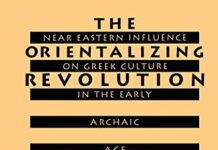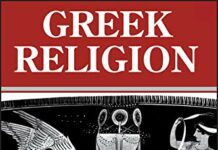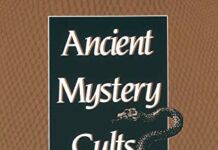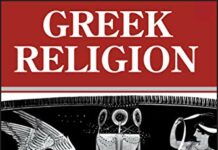
Ebook Info
- Published: 2004
- Number of pages: 248 pages
- Format: PDF
- File Size: 7.18 MB
- Authors: Walter Burkert
Description
“Tantalizingly rich . . . this is a splendid book.”–Greece and Rome “Burken relegates his learned documentation to the notes and writes in a lively and fluent style. The book is recommended as a major contribution to the interpretation of ancient Greek myth and ritual. The breadth alone of Burkert’s learning renders his book indispensable.”–Classical Outlook “Impressive. . . founded on a striking knowledge of the complex evidence (literary, epigraphical, archaeological, comparative) for this extensive subject. Burkert offers a rare combination of exact scholarship with imagination and even humor. A brilliant book, in which . . .the reader can see at every point what is going on in the author’s mind–and that is never uninteresting, and rarely unimportant.”–Times Literary Supplement “Burkert’s work is of such magnitude and depth that it may even contribute to that most difficult of tasks, defining myth, ritual, and religion. . [He] locates his work in the context of culture and the historv of ideas, and he is not hesitant to draw on sociology and biology. Consequently his work is of significance for philosophers, historians, and even theologians, as well as for classicists and historians of Greek culture. His hypotheses are courageous and his conclusions are bold; both establish standards for methodology as well as results. “–Religious Studies Review
User’s Reviews
Editorial Reviews: About the Author Walter Burkert was a German scholar of Greek mythology and cult. A professor of classics at the University of Zurich, Switzerland, he taught in the UK and the US.
Reviews from Amazon users which were colected at the time this book was published on the website:
⭐In very good shape and a very worthwhile read.
⭐”Structure and History in Greek Mythology and Ritual” is part of a surprisingly long list of books by Walter Burkert, now Professor Emeritus at the University of Zurich, which have appeared in English translation, beginning with “Lore and Science in Ancient Pythagoreanism” in 1972. This is unusual in an age of supposedly declining interest in Greek and Latin, particularly since his books, while generally packed with information, also address theoretical issues, and are not always easy to understand. A number of them have been controversial, either for his own ideas, or for his challenges to the accepted wisdom. However, they are usually very interesting. The present book, one of his shorter works, is no exception. And it, too, makes demands on the reader.[Note: Prof. Burkert (b. 1931) passed away in March 2015.]”Structure and History” forms Volume Forty-seven of the Sather Classical Lectures, an invitational series delivered by Visiting Professors at the University of California at Berkeley since early in the twentieth century, and shows every sign of being aimed at professional scholars. Like many of the other contributions to the lecture series (a surprisingly large number of which have found their way into paperback editions over the years), it keeps the really difficult material tucked away in notes, and the primary argument doesn’t need technical knowledge to follow. (Evaluating it is another matter.)”Structure and History” picks up issues raised in Burkert’s earlier, much longer, “Greek Religion” (in Britain, “Greek Religion: Archaic and Classical”), originally published in 1977, and translated in 1985. That is an engaging book which I found quite convincing, at least while reading it, as was the case with his shorter “Ancient Mystery Cults” (1987, originally the Carl Newell Jackson Lectures for 1982), with which it also has some overlaps.My reaction to Burkert’s book on killing as a ritual act, “Homo Necans: The Anthropology of Ancient Greek Sacrificial Ritual and Myth” (1972, translated 1983), was that Burkert got off on the wrong track on several matters. As Ian Morris put it about one of them in “Death-Ritual and Social Structure in Classical Antiquity” (1992), “Burkert’s derivation of funerary rituals from hunting and sacrifice … is … unnecessarily limiting.” But some of the ideas in “Homo Necans” appear in “Structure and History,” in what I found a more modest and acceptable form.In fact, except for “Lore and Science,” most of his books can be read as parts of a single investigation of ancient Greek religion in its various manifestations. And even “Lore and Science” deals with the Pythagoreans as a religious movement.”Structure and History in Greek Mythology and Ritual” appears to be a short survey, but it is NOT for beginners. If you aren’t familiar with at least a couple of roughly college-level surveys, you may find yourself lost. I’ve been reading the sources (Greek, Latin, and others) in translation) as well as studies, for several decades, and from time to time I found myself reaching for Tripp’s “Handbook of Classical Mythology” or Feder’s “Handbook of Classical Literature,” just to be sure I was following the argument correctly. Usually I was. Burkert isn’t all *that* desperately obscure (at least not in the old, oracular, German manner), but sometimes I needed to have some lesser-known variants or obscure sources identified. Those even more amateur than myself will do well to bear this in mind before trying the book. And it is worth trying.It could be used, I would think, as a mythological companion to Burkert’s “Greek Religion,” which deals mainly with sacred places, rituals, and other material and literary evidence, but only incidentally with mythological narratives. But it is rather heavily committed to basic issues of interpretive method, and is not aimed at fulfilling that function.The title hearkens back to watchwords of the previous hundred years, including the old Myth-and-Ritual School, following Frazer, and the Structuralists of the middle and late twentieth century, but Burkert has new information — mostly concrete data from the Ancient Near East — with which to address the same problems. In place of speculation and anthropology, he has datable texts, presenting myths, and describing or prescribing rituals. He assumes that the reader is already quite familiar with the Greek material, and goes directly to important themes, and the methodological issues they present.Burkert has covered some of the same material, with much else, in several different contexts: “The Orientalizing Revolution: Near Eastern Influence on Greek Culture in the Early Archaic Age” (1992) and, most recently, in “Babylon, Memphis, Persepolis: Eastern Contexts of Greek Culture” (2004). These return to the problems posed by evidence of older and contemporary civilizations, and their relationship to developments in Greece.The adventurous may also wish to try Burkert’s “Creation of the Sacred: Tracks of Biology in Early Religions” (1996), where again I find his work seeming to become too speculative. But it is interesting, quite enough to be worth the effort; and he may be right. He has treated some of the same problems in “Savage Energies: Lessons of Myth and Ritual in Ancient Greece” (1990, translated 2001).
⭐
Keywords
Free Download Structure and History in Greek Mythology and Ritual (Volume 47) (Sather Classical Lectures) in PDF format
Structure and History in Greek Mythology and Ritual (Volume 47) (Sather Classical Lectures) PDF Free Download
Download Structure and History in Greek Mythology and Ritual (Volume 47) (Sather Classical Lectures) 2004 PDF Free
Structure and History in Greek Mythology and Ritual (Volume 47) (Sather Classical Lectures) 2004 PDF Free Download
Download Structure and History in Greek Mythology and Ritual (Volume 47) (Sather Classical Lectures) PDF
Free Download Ebook Structure and History in Greek Mythology and Ritual (Volume 47) (Sather Classical Lectures)




